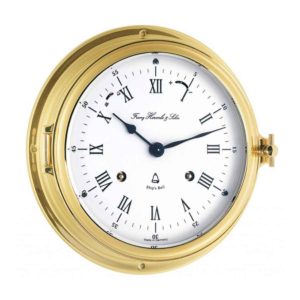The ship’s bell strikes in 30 minute increments over a four hour period of the day. There is one bell strike for each 30 minute segment beginning with a single bell strike at half past midnight and counting up to eight bell strikes at 4:00 a.m. marking the end of the four hour period.
At this point the bell strike pattern begins again at a single strike at 4:30 a.m. and counts up to eight strikes to 8:00 a.m.. This pattern of bell strikes – one to eight at half hour increments over four hours, is repeated throughout the day, breaking the 24 hours in the day into six distinct periods.

The ship’s bell system of chimes evolved from a crude sand clock dating back to the time of Columbus. This primitive clock was called a sand or sandglass clock, was a glass tube pinched to a narrow point in the middle, to allow sand to pass from the top half of the tube to the bottom half at a specific rate of time; and was an essential device for marking the time at sea.
Records of epic voyages tell us about this device and how the helmsman used it to measure time in half-hour increments by turning the glass when the sand ran through. It became customary to strike a bell at the same time so that whole crew knew the time; starting with one bell strike at the end of the first half hour, two at second and so on until reaching eight bells, which signalled the end of the four hour period. The tradition of the sand clock continued for hundreds of years and was replaced only by the development of the mechanical clock. But, it was not until the 19th century that the first mechanical ship’s bell clock was produced in America. The principle of this American innovation remains almost unchanged to this day.
Work shifts or “Watches”, were organized into increments of four hours on ships’ as mariners need to work 24 hours a day to keep the ship sailing; these four hour period are indicated by the ship’s bell system. Crews were organised into into teams that would work one four hour Watch and then rest before their next working Watch. However, as this four hour pattern resulted in six distinct periods in 24 hours – an even number, this meant that watch keepers would work the same Watches, repeatedly, day in, day out.
To introduce variation in the Watches and avoid this scenario, a mechanism called the “Dog Watches” is used. This occur in the 4:00 pm to 8:00 pm period, by splitting it into two shorter two-hour stints, and by doing so introduce a seventh – uneven number of periods. These short Watches also assist in the logistics of providing an evening meal for the whole crew, around the same time slot.
| Noon to 4:00 p.m. | Afternoon watch |
| 4:00 p.m. to 6:00 p.m. | First dog watch |
| 6:00 p.m. to 8:00 p.m. | Second dog watch |
| 8:00 p.m. to midnight | First night watch |
| Midnight to 4:00 a.m. | Middle watch or mid watch |
| 4:00 to 8:00 a.m. | Morning watch |
| 8:00 a.m. to noon | Forenoon watch |
|
Ship’s Bell Code |
|
4:00 |
8:00 |
12:00 |
= |
8 Bells |
|
4:30 |
8:30 |
12:30 |
= |
1 Bells |
|
5:00 |
9:00 |
1:00 |
= |
2 Bells |
|
5:30 |
9:30 |
1:30 |
= |
3 Bells |
|
6:00 |
10:00 |
2:00 |
= |
4 Bells |
|
6:30 |
10:30 |
2:30 |
= |
5 Bells |
|
7:00 |
11:00 |
3:00 |
= |
6 Bells |
|
7:30 |
11:30 |
3:30 |
= |
7 Bells |
|
8:00 |
12:00 |
4:00 |
= |
8 Bells |


